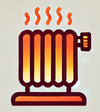Heater efficiency ratings tell you how effectively a heater converts energy into heat. These ratings are crucial for choosing a heating system that minimizes energy costs while maximizing comfort. The most common ratings include AFUE, HSPF, and SEER, each indicating efficiency in different types of heating systems.
Understanding these ratings helps you make informed decisions, ensuring you select a heater that meets your needs without very costly. Whether you’re upgrading your current system or installing a new one, knowing how to read and compare these ratings can lead to significant savings and a cozier home.
Heater Efficiency Ratings Explained
Heater efficiency ratings show how well a heater converts energy into heat. These ratings matter when choosing a heating system. Understanding them helps you save on energy costs and stay comfortable.
Annual Fuel Utilization Efficiency (AFUE)
AFUE measures the efficiency of furnaces and boilers. It indicates the percentage of fuel converted into heat over a year. For example, an AFUE rating of 80 means 80% of the energy becomes heat, while 20% is wasted. Higher ratings demonstrate better efficiency.
| AFUE Rating | Efficiency Level |
|---|---|
| 90% and above | High efficiency |
| 80% to 89% | Moderate efficiency |
| Below 80% | Low efficiency |
Heating Seasonal Performance Factor (HSPF)
HSPF applies to heat pumps. It measures the total heating output during a season compared to the energy used. A higher HSPF means better efficiency in transforming electricity into heat. For instance, an HSPF of 8.0 indicates good performance.
| HSPF Rating | Efficiency Level |
|---|---|
| 9 and above | Excellent |
| 8 to 8.9 | Good |
| Below 8 | Fair to poor |
Seasonal Energy Efficiency Ratio (SEER)
SEER rates the efficiency of cooling systems but can also relate to heaters when they provide cooling. It measures the total cooling output divided by energy used. A higher SEER indicates greater efficiency. For example, a SEER of 16 is more efficient than one rated at 13.
| SEER Rating | Efficiency Level |
|---|---|
| 16 and above | Highly efficient |
| 13 to 15 | Moderately efficient |
| Below 13 | Poor efficiency |
By understanding these ratings, you can select a heater that meets your needs and enhances energy savings. Each rating helps determine the overall efficiency, guiding you towards a more economical choice for heating your home.
Importance Of Heater Efficiency Ratings
Heater efficiency ratings play a vital role in choosing the right heating system. These ratings help you understand how well a heater converts energy into usable heat. Knowing these ratings can guide your decision-making process, leading to more comfort and lower energy bills.
Energy Savings
Energy-efficient heaters save you money. High ratings mean better fuel use, leading to lower energy bills. For example, a furnace with a 90% AFUE rating converts 90% of fuel into heat, wasting only 10%. This efficiency reduces monthly expenses, making your home heating more cost-effective over time. Choosing an efficient heat pump with a high HSPF rating, like 8 or 9, can also result in significant savings. You get more heat for each dollar spent, directly impacting your wallet.
Environmental Impact
Choosing efficient heaters also benefits the environment. Efficient systems burn fuel more completely, reducing emissions. Lower emissions contribute to cleaner air and a smaller carbon footprint. For instance, a high-efficiency furnace emits less CO2 than a standard model. Also, heat pumps with high HSPF ratings minimize the need for fossil fuels, relying on electricity instead. By selecting efficient heaters, you help reduce greenhouse gas emissions and promote sustainability. This choice not only impacts your home but also supports wider environmental goals.
Types Of Heater Efficiency Ratings
Heater efficiency ratings help you gauge how well a heater converts energy into heat. Knowing these ratings aids in selecting the best heating option for your needs.
AFUE Ratings
AFUE stands for Annual Fuel Utilization Efficiency. This rating applies to furnaces and boilers. The AFUE percentage reveals how much fuel the heater converts into usable heat over a year. A higher AFUE rating means better efficiency. For example, a furnace with a 90% AFUE uses 90% of its fuel to produce heat. Ratings above 90% are considered high efficiency. Choosing a furnace with a strong AFUE rating can significantly lower your energy bills.
HSPF Ratings
HSPF stands for Heating Seasonal Performance Factor. This rating is specific to heat pumps. HSPF measures the total heating output during the heating season, divided by the total energy input in watt-hours. A higher HSPF rating indicates a more efficient heat pump. For instance, heat pumps with HSPF ratings of 8 or higher provide excellent efficiency. Selecting a heat pump with a strong HSPF can lead to substantial energy savings.
How To Read Heater Efficiency Ratings
Understanding heater efficiency ratings helps in making informed decisions. You’ll see different ratings, each designed for specific heating systems.
Understanding The Numbers
Look for the Annual Fuel Utilization Efficiency (AFUE) percentage. A rating of 90% means 90% of the fuel goes into heat. Higher numbers are better. Heat pumps use the Heating Seasonal Performance Factor (HSPF). For instance, an HSPF of 8 or higher signals high efficiency. Finally, check the Seasonal Energy Efficiency Ratio (SEER) if the unit provides cooling. A higher SEER means more energy savings. These numbers directly influence heating costs.
Comparing Different Heaters
Compare the AFUE ratings of furnaces and boilers. For example, a 95% AFUE unit is more efficient than an 80% unit. Heat pumps should be compared using their HSPF ratings. A heat pump with an HSPF of 9 is superior to one with an HSPF of 7. When evaluating cooling systems with SEER ratings, a system with a SEER of 15 outperforms one rated at 12. Each of these comparisons highlights which system offers better performance and lower costs.
Factors Affecting Heater Efficiency
Heater efficiency depends on several key factors. Each factor influences how well your heating system performs. Understanding these aspects helps you make better choices.
Maintenance And Upkeep
Regular maintenance improves heater efficiency. Cleaning the filters keeps airflow strong. A clean system uses less energy. Inspecting the ductwork for leaks also prevents heat loss. Sealing leaks can boost efficiency by 10% to 20%. Schedule professional check-ups annually for optimal performance. Consider changing filters every one to three months, depending on usage.
Heating System Design
The design of your heating system plays an essential role in efficiency. Properly sizing your heater matters. An oversized unit consumes more energy and causes short cycling. A correctly sized system maintains steady temperatures without wasting fuel. Consider the layout of your home, too. Open floor plans allow for even heat distribution, improving overall efficiency. Insulation also influences design; well-insulated homes retain heat better, resulting in less energy usage.
Conclusion
Choosing an efficient heater is crucial for your comfort and budget. By understanding AFUE, HSPF, and SEER ratings, you can make smarter decisions that lead to significant energy savings. Remember, higher ratings translate to better performance and lower energy bills.
Regular maintenance is key to keeping your heating system running efficiently. Simple actions like changing filters and sealing duct leaks can enhance your heater’s performance.
Investing in an energy-efficient heater not only benefits your wallet but also supports a healthier environment. With the right knowledge and care, you can enjoy a warm home while minimizing your carbon footprint.








